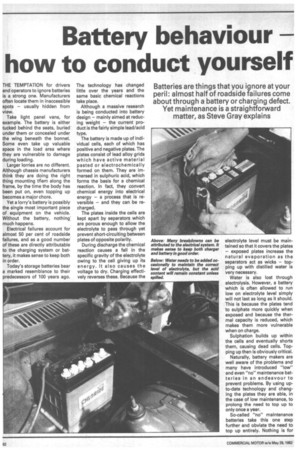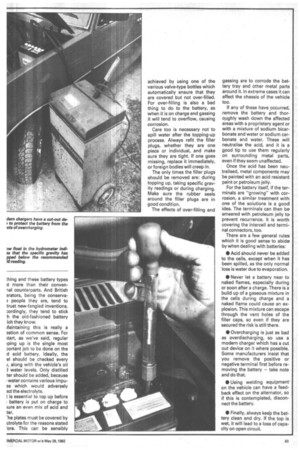Battery behaviour how to conduct yourself
Page 54

Page 55

If you've noticed an error in this article please click here to report it so we can fix it.
THE TEMPTATION for drivers and operators to ignore batteries is a strong one. Manufacturers often locate them in inaccessible spots — usually hidden from view.
Take light panel vans, for example. The battery is either tucked behind the seats, buried under them or concealed under the wing beneath the bonnet. Some even take up valuable space in the load area where they are vulnerable to damage during loading.
Larger lorries are no different. Although chassis manufacturers think they are doing the right thing mounting tHem along the frame, by the time the body has been put on, even topping up becomes a major chore.
Yet a lorry's battery is possibly the single most important piece of equipment on the vehicle. Without the battery, nothing' much happens.
Electrical failures account for almost 50 per cent of roadside failures, and as a good number of these are directly attributable to the charging system or battery, it makes sense to keep both in order.
Today's storage batteries bear a marked resemblance to their predecessors of 100 years ago. The technology has changed little over the years and the same basic chemical reactions take place.
Although a massive research is being conducted into battery design — mainly aimed at reducing weight — the current product is the fairly simple lead/acid type.
The battery is made up of individual cells, each of which has positive and negative plates. The plates consist of lead alloy grids which have active material pasted or electrochemically formed on them. They are immersed in sulphuric acid, which forms the basis for a chemical reaction. In fact, they convert chemical energy into electrical energy — a process that is reversible — and they can be recharged.
The plates inside the cells are kept apart by separators which are porous enough to allow the electrolyte to pass through yet prevent short-circuiting between plates of opposite polarity.
During discharge the chemical reaction causes a fall in the specific gravity of the electrolyte owing to the cell giving up its energy. It also causes the voltage to dry. Charging effectively reverses these. Because the electrolyte level must be maintained so that it covers the plates — exposed plates increase the natural evaporation as the separators act as wicks — topping up with distilled water is very necessary.
Water is also lost through electrolysis. However, a battery which is often allowed to run low on electrolyte level simply will not last as long as it should. This is because the plates tend to sulphate more quickly when exposed and because the thermal capacity is reduced, which makes them more vulnerable when on charge.
Sulphation builds up within the cells and eventually shorts them, causing dead cells. Topping up then is obviously critical.
Naturally, battery makers are well aware of the problems and many have introduced "low" and even "no" maintenance batteries in an endeavour to prevent problems. By using upto-date technology and changing the plates they are able, in the case of low maintenance, to prolong the need to top up to only once a year.
So-called "no" maintenance batteries take this one step further and obviate the need to top up entirely. Nothing is for
thing and these battery types A more than their convennal counterparts. And British arators, being the conserve3 people they are, tend to trust new-fangled inventions. :ordingly, they tend to stick h the old-fashioned battery ich they know.
Maintaining this is really a astion of common sense. For tart, as we've said, regular oping up is the single most portant job to be done on the d acid battery. Ideally, the el should be checked every f, along with the vehicle's oil J water levels. Only distilled ter should be added, because I water contains various impues which would adversely act the electrolyte.
t is essential to top up before battery is put on charge to Aire an even mix of acid and ter.
he plates must be covered by ctrolyte for the reasons stated 'ore. This can be sensibly achieved by using one of the various valve-type bottles which automatically ensure that they are covered but not over-filled. For over-filling is also a bad thing to do to the battery, as when it is on charge and gassing it will tend to overflow, causing corrosion.
Care too is necessary not to spill water after the topping-up process. Always refit the filler plugs, whether they are one piece or individual, and make sure they are tight. If one goes missing, replace it immediately, or foreign bodies will creep in.
The only times the filler plugs should be removed are: during topping up, taking specific gravity readings or during charging. Make sure the rubber seals around the filler plugs are in good condition.
The effects of over-filling and gassing are to corrode the battery tray and other metal parts around it. In extreme cases it can affect the chassis of the vehicle too.
If any of these have occurred, remove the battery and thoroughly wash down the affected areas with a proprietary agent or with a mixture of sodium bicarbonate and water or sodium carbonate and water. These will neutralise the acid, and it is a good tip to use them regularly on surrounding metal parts, even if they seem unaffected.
; Once the acid has been neuitralised, metal components may be painted with an acid resistant paint or petroleum jelly.
For the battery itself, if the terminals are "growing" with corrosion, a similar treatment with one of the solutions is a goodl idea. The terminals can then be smeared with petroleum jelly to prevent recurrence. It is worth, covering the intercell and terminal connectors, too.
There are a few general rules which it is good sense to abide by when dealing with batteries: • Acid should never be added to the cells, except when it has been spilled, as the only normal loss is water due to evaporation.
• Never let a battery near to naked flames, especially during or soon after a charge. There is a build up of a gaseous mixture in the cells during charge and a naked flame could cause an explosion. This mixture can escape through the vent holes of the filler caps, so even if they are secured the risk is still there.
• Overcharging is just as bad as overdischarging, so use a modern charger which has a cut out device on it where possible. Some manufacturers insist that you remove the positive or negative terminal first before removing the battery — take note and do that.
• Using welding equipment' on the vehicle can have a feedback effect on the alternator, so if this is contemplated, disconnect the battery.
• Finally, always keep the battery clean and dry. If the top is wet, it will lead to a loss of capacity on open circuit.
































































